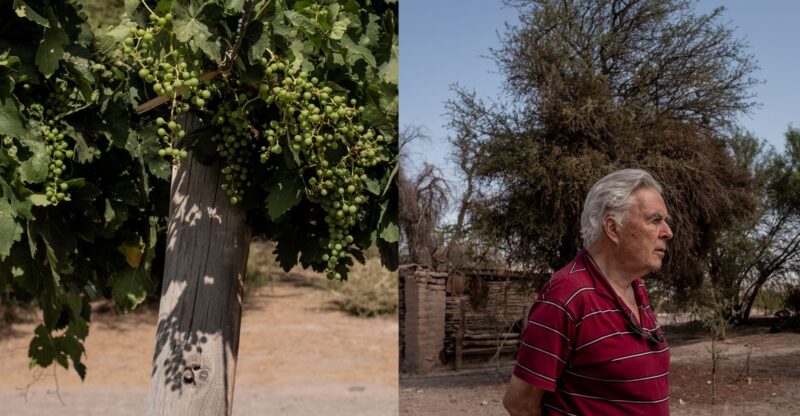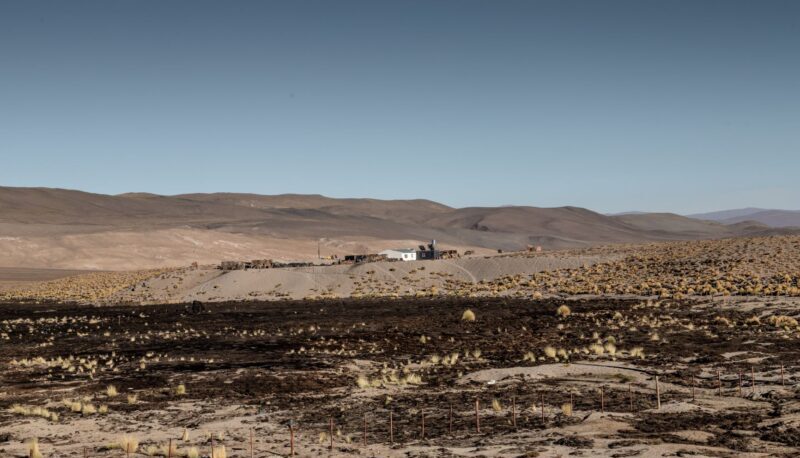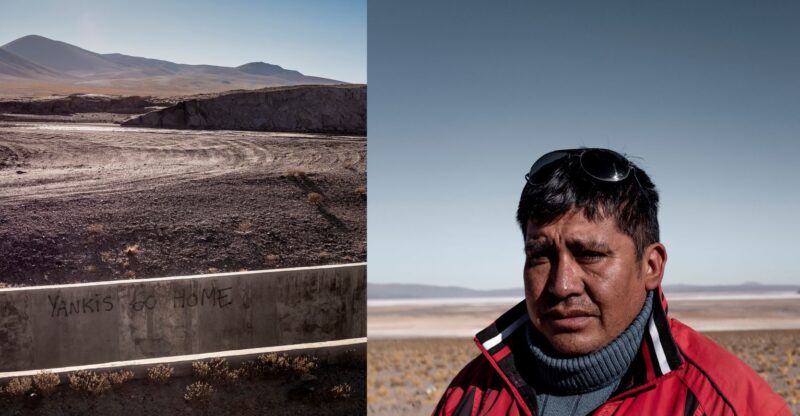Under a pale lavender sky, four women walk up to a small house, in Fiambalá, a small mountain town, in the northern reaches of Argentina.
This is the third door they have knocked on this December night, armed with a notebook of maps and statistical information, and an appeal they have been delivering for months.
They hope to add another signature to their petition against a new lithium project on their doorstep. The Catamarca province, in northwestern Argentina, is rich in the resource that is supposed to fuel a green revolution.
“It’s like a man was just telling us, the mining company is dominating the municipality,” Yolanda Espinoza, a high school teacher, told Maria Julia Idiarte, who answered the door.
“There are laws, but they’re not being respected,” she said, sitting next to her collaborator Beatriz Perea, a university professor. The women are part of the Asamblea Fiambalá Despierta (Fiambala Wakes Up), an organisation formed to oppose a lithium project spearheaded by the Argentinian mining company Liex. It is owned by Canada’s Neo Lithium, which recently announced it would be purchased by China’s Zijin Mining Group.
The Tres Quebradas project is 4,200 metres above sea level among an ethereal landscape of volcanoes, flamingos and vicuñas – small llamas – in an internationally protected wetland in the province of Catamarca. But it’s the salt flats, that shimmer like a mirage, that are turning more heads lately.
Tres Quebradas is part of a wave of lithium exploration in Argentina spurred by an urgent global imperative to shift away from fossil fuels. Branded as a solution to our climate change woes, lawmakers and residents are eager to tap into the economic benefits that the industry may bring.
Yet, there are divisions increasingly visible in the communities that dot the “lithium triangle” at the intersection of Argentina, Bolivia and Chile. Indigenous peoples, farmers, activists and scientists have launched legal challenges, conducted investigations, staged road blockades and marched against lithium projects. The concerns of Asamblea Fiambalá Despierta are typical: they centre around the impact on local water sources and land.
Liex bills itself as a different kind of mining company — and after five years of exploration and assessments, is awaiting final approval for production to begin.
“It’s clear that our representatives are selling out,” said Espinoza. “But if the town doesn’t raise its voice — that’s what we’re trying to make people understand: that the village can go out and protest.”

Julieta Carrizo stands in front of graffiti protesting the Liex mining project in Fiambala (All photos: Anita Pouchard Serra)
Green revolution
This is boom time for lithium. Mining for the lightest metal on Earth has been on the rise since the 1990s due to surging demand for batteries to power our phones and computers. The advent of the electric car, and its promise of a cleaner future, has thrust the lithium rush into high gear. In Argentina, a country hurtling from one economic crisis to another, both the national and provincial governments have pitched lithium development as an important opportunity.
“The objective… is to continue developing the industrialisation of lithium and in that sense we are receiving very good proposals every day. We see genuine and real interest in the development of the entire chain,” said Matías Kulfas, Argentina’s minister of productive development, who oversees industrial policies, in April 2021 as he unveiled a national committee on lithium with the northern provinces of Jujuy, Catamarca and Salta.
“Catamarca is mining,” its governor Raúl Jalil said at the time. “[We are looking for] sustainable mining that spills into the communities and generates more work.” Catamarca alone has 15 lithium projects, most in the initial stages of prospecting or exploration, with names like “Salt of Life” and “Salt Gold”. The companies include stalwarts such as US-based Livent, the first lithium producer in Argentina, which is planning an expansion, and Australian Galaxy Resources. A growing player in the area, South Korea’s Posco, has announced plans to spend $830 million (£692 million) on a lithium processing plant with an annual production capacity of 25,000 tonnes of lithium hydroxide, which it says can power 600,000 electric vehicles.
There is a catch, said Marcelo Sticco, a geologist and member of a research group at the University of Buenos Aires that studies lithium mining in northern Argentina. “We’re all in favour of the energy transition and reducing the use of fossil fuels,” he said. “But locally it produces an irreversible impact with respect to water.”

Alfredo Morales, a member of the Atacameños del Altiplano community, with his daughter and an old picture of his family, in Antofagasta de la Sierra
Community concerns
Communities in Latin America have heard promises of prosperity before. Large scale copper and gold mining projects that left behind environmental ruin have poisoned the well of trust.
Massive protests in the south of Argentina last month prompted the governor of the province of Chubut to quash a bill its legislature had just approved to allow mining. The lithium protesters in Fiambalá consider themselves to be part of the same battle against massive extraction.
In Argentina, lithium falls under a category of mining that allows companies to explore and mine without owning the land, while the government is not permitted to do the same. That means that the benefit to state coffers comes through taxes. In many cases, mining companies end up as stand-ins for the state through community spending and infrastructure improvement that is considered by supporters as a social responsibility and by opponents as a ploy to win hearts.
“The only way to know if you are doing things right is by walking,” said Carlos Arizu, the owner of Tizac wineries, on the edge of Fiambalá. Tizac is one of the larger producers in the area, with some 200,000 bottles a year. “The grape talks and this vine is lacking water,” he told Climate Home News.
Arizu used to get his water from a mountain glacier, like the rest of the town, but a few years ago he drilled 80 metres underground and now pays to pump water up to his plants. The price of the water jumps by leaps and bounds with Argentina’s chronically high inflation, so he has to measure his usage to make sure he doesn’t go broke.
“We’re all small producers, the average vineyard is less than one hectare,” said Arizu. “There is not enough water for the producers that exist.”
A report published in 2021 by the nonprofit BePe (Bienaventuradores de Pobres) identified the potential impact on water – which is part of lithium processing – as a chief concern, saying that not enough research had been done on the potential contamination of water or the ability of underground water sources to recharge.

LEFT Carlos Arizu ‘s vineyard. RIGHT Carlos Arizu, owner of the Tizac wines. Fiambala has many small wine producers who need water to continue their production. Some are concerned about the water usage of lithium mining in the region.
“Faced with the innumerable uncertainties about environmental prejudices and possible ecosystem damage, the activity must be stopped until studies are available to reliably determine the magnitude of the damage,” the report stated, noting that “neighbours denounce that the legitimate right to public consultation was not respected.”
Matías Berardini told Climate Home News that he understands the scepticism considering the track record that mining has. Berardini, the general manager of Liex’s “community relations” office in Fiambalá, located around the corner from the main square, said the company has taken steps to dispel myths, contribute to the community, and marshal those who knock on their doors looking for work.
“The deposit is very good in its composition, storage, in the amount of lithium, and that allows us to work in a way that is very efficient,” he said.
Concerns over water usage, he said, are “an old excuse” but “as a mining company we need to ensure that the fear disappears”.
“In comparison to other lithium projects, we consume much less water. We’re always less than 50% of any other project. It’s not that we’re the best guys in the world, it’s just that the chemistry in our salt flat allows us to use a much more natural process,” said Berardini.
#mc_embed_signup{background:#fff; clear:left; font:14px Helvetica,Arial,sans-serif; }
/* Add your own Mailchimp form style overrides in your site stylesheet or in this style block.
We recommend moving this block and the preceding CSS link to the HEAD of your HTML file. */
Liex will use pumps to suck out brine rich in lithium and other minerals, and pour it into pools to evaporate until the concentration of lithium reaches 3-4%. It will then be transported by truck to a plant on the outskirts of Fiambala for a chemical process that results in lithium carbonate.
The company says that brine it is drawing on in the salt flat to extract lithium comes from a basin that has no connection to the town’s water supply.
Pia Marchegiani, director of environmental politics at Argentina’s Fundación Ambiente y Recursos Naturales (Environment and Natural Resources Foundation) said statements like these are misleading.
“Just because it’s not being consumed by people doesn’t mean it will not have an impact,” she told Climate Home News. “It is fulfilling an ecosystem function that has not been studied. If that salt water displaces, runs into, or invades the fresh water, there will be an impact,” she said.
Patricia Marconi, a biologist and president of the Fundacion Yuchan, a conservation NGO, said the company uses the same amount of salt water in its evaporation process as any other company that uses that method. It uses less in other subsequent stages of the process, but the information available is incomplete.
“They aren’t declaring the amount of freshwater that they will extract for the processing stage, that they will be drawing on from the Abaucan basin, the same one that supplies Fiambala,” Marconi told Climate Home News. “It is the same aquifer. That’s in the environmental assessment and they can’t deny it.”
Marchegiani highlighted another less discussed risk: the carbon that is trapped in microorganisms in the salt flat. “The last thing we want is for a carbon sink to become a carbon source,” she said.

View of the Trapiche meadow in the Salar del Hombre Muerto, dried up after the installation of a dam by the Livent company
The risk depends on the method of extraction, said Sticco. Companies that use evaporation to precipitate lithium from heavily salted brine underground pose the most serious threat, he said, because of the composition of the water underground. Sticco likened the salt flat to a sponge with underground pores that contain freshwater and salinated water. “There isn’t a wall that separates the two waters. There is a border of freshwater and a nucleus of very salinated water and an area that is mixed. So when you take from the middle, that has lithium, you move all the water,” he said. “Freshwater turns into salt water,” he said.
The process of precipitation also leaves behind large amounts of metals that were originally underground — elements like cadmium, lead, manganese and copper — that if not properly disposed of can contaminate superficial water sources, said Sticco. He noted a “double standard” in Argentina — rules demand that the petroleum industry properly remediate similar toxic waste, but no such rules apply to lithium mining.
Berardini acknowledged that certain risks exist with the project — the movement of trucks being one of them, along with ensuring the responsible operation of the chemical processing plant.
“But the potential for impact is very low,” he said. “What did we bring to an area like Fiambalá? Well, the prospect of work that pays much more than the median.”
Indeed, the town of 8,000, like the rest of Catamarca, struggles with unemployment. The Liex project promises to create 300 permanent jobs at a chemical processing plant, and another 1,000 in offshoot industries. “I earn double of what my brother, who works for the municipality, earns,” said one Liex miner who asked to remain anonymous.
For Julieta Carrizo, 27, the company line is spin. The youngest member of the Fiambalá Asamblea, she recently returned to live in the town where her grandparents lived.
“I went to Liex, they defended everything without any real arguments. Everything was in metaphors. And they ended up offering me a job, as I kept arguing,” said Carrizo. She is more interested in the hard numbers. Liex says it takes 14 cubic metres of water to produce 1 tonne of lithium carbonate. With a production goal of 20,000 tonnes a year, that works out at more than 700,000 litres of water a day.
“They sell it like it’s renewable energy, and it’s green, and people catch on to that, and they think they want to be part of the future, but they don’t see that it’s a neocolonial practice that is the same as always, but with a refresh,” she said.
Lithium’s water problem
Some 500 kilometres away, ensconced between red rockfaces 3,500 metres above sea level, Román Guítan zooms into a Google Earth satellite image of the Salar del Hombre Muerto, the Dead Man’s Salt Flat. This is the northern end of Catamarca, where the US chemical company Livent is in the middle of a $640 million expansion of its Fenix lithium mine, which has been in operation for more than 20 years. At least five other projects are under exploration or extraction in the immediate vicinity.

Roman Guitan, leader of the Atacameños del Altiplano community poses in the salt flat ‘Salar del Hombre Muerto’
“This that you see here, all in yellow. That’s the meadow that is in danger,” said Guítan, pointing to a patch on a map to the east of the salt flat, from which a tributary flows.
He’s sitting at the kitchen table of Alfredo Morales and Eli Mamani, in Antofagasta de la Sierra, a small mountain town near the Livent mining project. They are members of a Diaguita community of around 40 people called Atacameños del Altiplano. Guítan is its chief. His home is located within eyesight of the Livent mining project — he skirts the processing plant on his way to and from Antofagasta de la Sierra, keenly aware of the mine security vehicles that shadow him at a distance. Livent’s expansion threatens the gravesite of Guítan’s great grandfather, metres from a road used by mining trucks, and the remains of an unidentified man his great grandfather discovered, after whom the Dead Man Salt Flat is named.
Livent’s expansion plans will see it draw water from an aquifer under Los Patos river, the most important water source in the region.
A 2020 report published by national green group Farn on behalf of Catamarcan activists sets out the objections to this plan. The organization said the project was approved by the provincial government without proper consultation of local and indigenous communities. It cited an environmental impact report by Livent that requested the withdrawal of 650,000 litres of water from Los Patos an hour — noting that four other companies have made similar petitions for “huge” amounts of water from the same river.
Livent did not respond to requests for comment from Climate Home News.
Sticco the geologist says the data his group has viewed does not show a significant impact on local water sources. Unlike another lithium project in the neighbouring province of Jujuy, which not only depleted the community’s water source but left behind an expensive cleanup of toxic waste, Livent’s numbers suggest the consumption of water is “pretty minimal” because they do not employ a conventional evaporation technique.
“That being said, I’m keeping the yellow [caution] light on [with their project],” he says.
The issue, said Marconi, is that there aren’t inventories on the amount of underground water that exists, making it difficult to say how the Livent process is affecting the supply.
“There is a very serious problem here in that they evaluate the amount and quality of lithium but they don’t assess the amount of water that exists,” said Marconi.
Guítan and his allies say more than caution is required.
“They’ve labelled us as anti-mining, that we are trying to block things, that we are against progress. The government and the companies say that, but that’s not true,” says Alfredo Morales, who argues there should be “controlled” mining that leaves resources in the ground.
“Now the latest is that they’re trying to tell us that the water they use is ‘industrial’. That it isn’t fit for human consumption,” he said. “But we’ve been drinking that water for more than a century.”
The community has already seen what it believes to be the consequences of the project — a meadow associated with the Trapiche River is dry, and no one has taken responsibility for that, says Guítan.
This revelation was documented in the Farn report, and described as “irreversible damage” to the ecosystem.
“The drying up of plains and rivers is just the tip of the iceberg of an environmental deterioration on the fragile balance of the Puna and the violation of the rights of indigenous peoples and the communities that inhabit the place,” it wrote.
More recently, Guítan lodged a complaint about the large-scale death of trout — something he says that the company has denied ever occurred
“That’s why we’re very afraid that the same thing will happen with the meadow where I live. We use it from December to March. It feeds sheep, llamas, vicuñas, ducks, seagulls. It’s a beautiful place,” he said. “If they end up drying that up, we’ll lose it all.”
This article is part of a climate justice reporting programme supported by the Climate Justice Resilience Fund. Cover image: A brine evaporation pool at Liex’s 3Q lithium mine project in the salt flat of Tres Quebradas near Fiambala, Catamarca, Argentina. Photo by Anita Pouchard Serra.